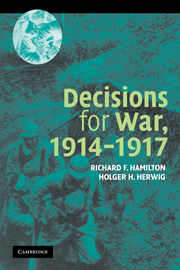Book contents
- Frontmatter
- Contents
- LIST OF MAPS
- MAP 1 General map of Europe: June 1914
- ACKNOWLEDGMENTS
- 1 The Great War: A Review of the Explanations
- 2 European Wars: 1815–1914
- 3 Austria-Hungary
- 4 Germany
- 5 Russia
- 6 France
- 7 Great Britain
- 8 Japan; The Ottoman Empire
- 9 Bulgaria, Romania, and Greece
- 10 Italy
- 11 The United States
- 12 On the Origins of the Catastrophe
- RECOMMENDED READING
- INDEX
11 - The United States
Published online by Cambridge University Press: 05 June 2012
- Frontmatter
- Contents
- LIST OF MAPS
- MAP 1 General map of Europe: June 1914
- ACKNOWLEDGMENTS
- 1 The Great War: A Review of the Explanations
- 2 European Wars: 1815–1914
- 3 Austria-Hungary
- 4 Germany
- 5 Russia
- 6 France
- 7 Great Britain
- 8 Japan; The Ottoman Empire
- 9 Bulgaria, Romania, and Greece
- 10 Italy
- 11 The United States
- 12 On the Origins of the Catastrophe
- RECOMMENDED READING
- INDEX
Summary
In April 1917 the United States entered World War I on the side of the Allies. The decision-making process and the grounds for entry were very different from those reviewed in previous chapters. There has been, understandably, much contention about the causes and significance of this action. Most contenders have been Americans – historians, journalists, popular writers, and, occasionally, politicians. The contention was most intense, curiously, in the 1930s, as Americans again saw the breakdown of international order and the approach of another major war. Since that time, the argument has largely subsided and has usually involved only a few historians.
Evaluation has been one central concern in these discussions – whether intervention was a good or a bad thing? Did it bode well or ill for the future of the United States and the world? Many of these accounts made worthwhile contributions to our knowledge of the event, although many were highly colored with emotion and value judgments. A frequent element in those discussions was denigration of the role of individual actors. Partisans on both sides of the debate over the wisdom and morality of intervention have argued instead that some “great forces” of history – geopolitics, economics, and/or culture – largely determined what happened. With rare exceptions, these interpreters viewed individual decision-makers as witting or unwitting, honest or devious agents of great forces.
- Type
- Chapter
- Information
- Decisions for War, 1914–1917 , pp. 202 - 224Publisher: Cambridge University PressPrint publication year: 2004



